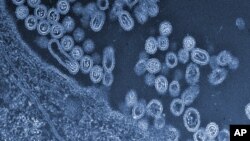Research scientists who sparked global alarm in 2011 with a laboratory-grown strain of bird flu, are seeking to try such experiments again with a new strain that has killed at least 43 people in China this year.
The proposal for research came Wednesday in an open letter from 22 prominent influenza researchers, stressing the need for new studies on the H7N9 virus that first appeared in March in eastern China.
The letter, published in the research journal Nature, and separately in Science, comes a day after Chinese scientists reported the first probable case of person-to-person transmission of the H7N9 virus.
The 2011 research on the H5N1 influenza strain ignited a fierce ethical debate, after scientists in the United States and the Netherlands deliberately engineered the virus to identify mutations that could make naturally-occurring strains easier to spread.
Critics immediately voiced security concerns, raising fears that terrorists gaining access to the research could unleash a virulent, laboratory-grown strain and cause mass deaths. Those fears brought about a voluntary year-long moratorium on similar research, after a push by a U.S. biosecurity panel to block publication of the studies.
In a related development Wednesday, the U.S. Department of Health and Human Services said any new H7N9 research requiring U.S. funding will face new and strict safety reviews and will require secure facilities.
Two key signatories of Wednesday's letter, Ron Foucher of Rotterdam's Erasmus Medical Center and Yoshihiro Kawaoka from the University of Wisconsin, said they are prepared to demonstrate how the new research can be done safely.
On Tuesday, the British Medical Journal published findings showing for the first time the probable transmission of the H7N9 virus from a Chinese father to his adult caretaker daughter in March. The previously-healthy 32-year-old woman provided direct and unprotected bedside care for her ailing father, who died six weeks after falling sick. The daughter died one month later.
The proposal for research came Wednesday in an open letter from 22 prominent influenza researchers, stressing the need for new studies on the H7N9 virus that first appeared in March in eastern China.
The letter, published in the research journal Nature, and separately in Science, comes a day after Chinese scientists reported the first probable case of person-to-person transmission of the H7N9 virus.
The 2011 research on the H5N1 influenza strain ignited a fierce ethical debate, after scientists in the United States and the Netherlands deliberately engineered the virus to identify mutations that could make naturally-occurring strains easier to spread.
Critics immediately voiced security concerns, raising fears that terrorists gaining access to the research could unleash a virulent, laboratory-grown strain and cause mass deaths. Those fears brought about a voluntary year-long moratorium on similar research, after a push by a U.S. biosecurity panel to block publication of the studies.
In a related development Wednesday, the U.S. Department of Health and Human Services said any new H7N9 research requiring U.S. funding will face new and strict safety reviews and will require secure facilities.
Two key signatories of Wednesday's letter, Ron Foucher of Rotterdam's Erasmus Medical Center and Yoshihiro Kawaoka from the University of Wisconsin, said they are prepared to demonstrate how the new research can be done safely.
On Tuesday, the British Medical Journal published findings showing for the first time the probable transmission of the H7N9 virus from a Chinese father to his adult caretaker daughter in March. The previously-healthy 32-year-old woman provided direct and unprotected bedside care for her ailing father, who died six weeks after falling sick. The daughter died one month later.






